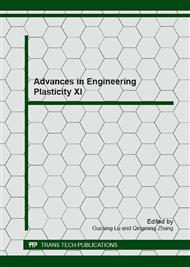p.357
p.361
p.365
p.369
p.373
p.377
p.381
p.385
p.389
Bi-Directional Evolutionary Structural Optimization for Design of Compliant Mechanisms
Abstract:
This research presents a topology optimization approach based on Bi-directional Evolutionary Structural Optimization (BESO) for optimal design of compliant mechanisms. Due to the complexity of the design for various compliant mechanisms, a new multi-objective optimization model is established by considering the mechanism flexibility and structural stiffness simultaneously. The sensitivity analysis is performed by applying the adjoint sensitivity approach to both the kinematical function and the structural function. The sensitivity numbers are derived according to the variation of the objective function with respect to the design variables. Some numerical examples are given to demonstrate the effectiveness of the proposed method for the design of various compliant mechanisms.
Info:
Periodical:
Pages:
373-376
Citation:
Online since:
January 2013
Authors:
Price:
Сopyright:
© 2013 Trans Tech Publications Ltd. All Rights Reserved
Share:
Citation:


